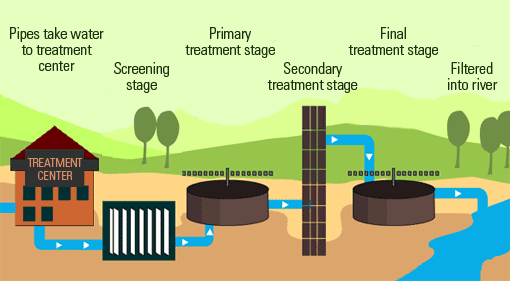Strategic Approaches to Enhance Drainage Therapy Effectiveness and Decrease Ecological Impact
In the world of waste water therapy, the quest for boosted efficiency and lowered ecological impact is a perpetual difficulty that demands calculated options. As culture faces the essential to take care of water resources sustainably, a nuanced method comes to be essential. The assimilation of innovative therapy innovations, energy-efficient procedures, source healing methods, improved nutrient elimination techniques, and clever surveillance and control systems represents a diverse structure for resolving these pushing problems. Nonetheless, what lies at the core of this facility internet of approaches is the possible to reinvent the way we come close to waste water therapy, not equally as a procedure of disposal, yet as a beneficial opportunity for advancement and ecological stewardship.
Advanced Treatment Technologies
Advanced membrane filtration systems have revolutionized sophisticated wastewater therapy processes, considerably improving the removal of impurities. These cutting-edge systems work by compeling water via a semi-permeable membrane, effectively separating pollutants from the water stream. The membrane layer's tiny pores catch toxins such as bacteria, viruses, and suspended solids, permitting just purified water to pass through. This innovation has shown to be highly effective in getting rid of a broad array of impurities, including drugs, hefty steels, and organic substances, which are typically challenging to remove via standard treatment techniques.
In addition, membrane layer filtration systems provide many benefits over standard therapy methods. Furthermore, these systems are very flexible and can be conveniently integrated into existing treatment plants or used as standalone devices for decentralized applications.
Energy-Efficient Processes
The combination of energy-efficient procedures in wastewater treatment systems is important for enhancing resource utilization and lowering functional costs. One essential technique to boosting power efficiency in wastewater therapy is the use of sophisticated oygenation systems, such as great bubble diffusers or surface aerators, which can improve oxygen transfer effectiveness and lower energy usage.
In addition, maximizing procedure control and automation with the usage of innovative sensing units and keeping track of systems can enhance total power performance by readjusting operations in real-time based on real need and conditions. Carrying out energy audits and consistently keeping an eye on energy performance indications are essential practices to determine areas for improvement and track energy-saving initiatives effectively. Generally, the fostering of energy-efficient processes in wastewater treatment not just benefits the setting however likewise contributes to long-lasting cost savings and functional sustainability.
Resource Healing Strategies
With a focus on optimizing source usage and sustainability in wastewater treatment systems, the implementation of resource healing strategies arises as a pivotal element in improving operational efficiency. Resource recovery methods in wastewater treatment entail the identification and extraction of important sources from the waste stream, thus transforming what was when taken into consideration waste into a valuable possession. By applying resource recovery methods such as nutrient removal and recovery, power generation from raw material, and the manufacturing of reusable water, wastewater therapy plants can decrease environmental impact while taking full advantage of efficiency.

Boosted Nutrient Removal Techniques
Executing advanced nutrient elimination methods is crucial for enhancing the efficiency of wastewater therapy systems. One of the key methods made use of for boosted nutrient removal is the process of organic nutrient elimination (BNR), which involves the removal of nitrogen and phosphorus via biological procedures.

In enhancement to BNR, advanced treatment approaches such as membrane bioreactors (MBRs) and built marshes can likewise be employed to improve nutrient elimination efficiency. MBRs utilize membranes to accomplish premium effluent standards by successfully getting rid of nutrients and put on hold solids. Constructed wetlands resemble natural wetland processes to eliminate nutrients via plant uptake, microbial task, and sedimentation. By including these innovative nutrient removal methods into wastewater treatment systems, communities and markets can properly reduce nutrient contamination and secure the setting.
Smart Tracking and Control Solution
Utilizing cutting-edge technology, the integration of smart surveillance and control systems changes the operational efficiency of wastewater therapy facilities. These systems incorporate advanced sensing units and data analytics to continually keep an eye on essential parameters such as pH degrees, turbidity, dissolved oxygen, and flow prices in real-time. By gathering and evaluating this data, drivers can get important understandings into the efficiency of Related Site the treatment procedures, making it possible for aggressive modifications to optimize treatment efficiency.
Smart monitoring and control systems additionally sustain remote surveillance capabilities, enabling drivers to gain access to real-time information and control functions from off-site areas. This remote availability improves functional flexibility and responsiveness, making it possible for swift treatments in case of system malfunctions or variations in influent top quality. In addition, the predictive maintenance abilities of these systems aid protect against equipment failures and decrease downtime, ultimately improving the overall dependability of wastewater therapy operations (Waste Water Treatment).
Final Thought
In verdict, tactical techniques such as innovative treatment modern technologies, energy-efficient procedures, source recuperation Continued techniques, improved nutrient removal methods, and wise tracking and control systems play an essential function in improving wastewater treatment efficiency and minimizing environmental impact. By executing these methods, wastewater therapy plants can improve their overall performance, decrease energy consumption, recover useful sources, and make sure compliance with environmental policies. These approaches are crucial for reliable and lasting wastewater monitoring methods.

In conclusion, critical methods such as innovative therapy innovations, energy-efficient procedures, resource healing strategies, improved nutrient removal methods, and smart surveillance and control systems play a vital role in improving wastewater therapy effectiveness and minimizing environmental effect.
Comments on “The Importance of Chemical Processes in Waste Water Treatment”